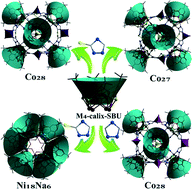Constructing calixarene-supported high nuclearity Co27, Co28 and Ni18Na6 clusters with triazoles as co-bridges†
Abstract
Three nanosized flying saucer-like cobalt compounds, [Co28(TC4A)6(3-SH-trz)8(di-S-trz)4(SO4)Cl10(OH)4(CH3OH)4(H2O)6] (CIAC-210), [Co27(TC4A)6(3-SH-trz)8(di-S-trz)4(CO3)0.25(SO3)0.75Cl10(OH)2(CH3OH)2(H2O)4] (CIAC-211) and [Co28(TC4A)6(trz)16(CO3)Cl11(OH)3(CH3OH)2(H2O)6] (CIAC-212), and one ring-like mixed NiNa compound, [Ni18Na6(TC4A)6(3-S-trz)6Cl6(H2O)6] (CIAC-213), were obtained by solvothermal reactions of the metal salts, p-tert-butyltetrathiacalix[4]arene (H4TC4A) and 1H-1,2,4-triazole-3-thiol (1H-3-SH-trz)/1H-1,2,4-triazole-3-carboxylic acid (1H-3-COOH-trz). All these four compounds are feathered with some shuttlecock-like secondary building units (SBUs) which are constructed by four metal atoms capped by a calixarene molecule. In CIAC-210, -211 and -213, the M4-TC4A SBUs are bridged together by 3-SH-trz and its dimer, forming high nuclearity clusters, while in CIAC-212, the SBUs are bridged by 1H-1,2,4-triazole (trz). It is found that not only the kind of metal and the molar ratio of the reactants play important roles in the formation of the clusters, but also the mixed solvents and their ratio affect the final structures. Magnetic measurements suggested that the metal centers exhibit antiferromagnetic interactions for all these four compounds.


 Please wait while we load your content...
Please wait while we load your content...